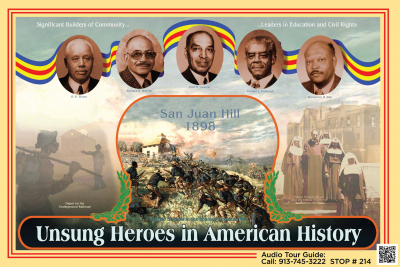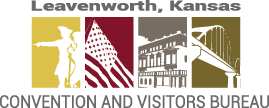Wayside Tour #14: Unsung Heroes of Leavenworth's African-American History
Wayside Tour #14: Unsung Heroes of Leavenworth's African-American History
The distinguished ladies and gentlemen presented here made significant contributions to military, education, civil rights and community service. Mr. Blanche K. Bruce is known for having tutored approximately 1800 young men for entrance to the military service academies with only three failing to qualify. He was the first black graduate of the University of Kansas and was Principal of Sumner Elementary School for 54 years.
Mr. Richard Warren served as teacher and principal in two schools and taught many generations of Leavenworth citizens, gaining the love and respect of the entire community. Mr. Warren retired from the Leavenworth school system after 34 years but continued to serve as a substitute teacher whenever called upon. The Richard W. Warren Middle School was named in his honor.
Mr. Earl M. Lawson served the Leavenworth school system for 34 years. As principal of Lincoln School, he told his graduating students "Let your decorum rise to the dignity of the occasion." Mr. Lawson was known as an early civil rights leader who in 1925 refused to take a back seat on a Leavenworth bus. Lincoln School was renamed the Earl M. Lawson Elementary School in 1998.
Mr. Donald L. Hollowell graduated from Leavenworth High School and became a distinguished civil rights lawyer in Atlanta, Georgia, defending many civil rights cases, including the Reverend Dr. Martin Luther King, Jr. A stretch of highway in Georgia is named after him.
Mr. Benjamin Day served 31 years in the Leavenworth school system as teacher and principal. The Ben Day Elementary School and the Ben Day Women's Center at Saint John Hospital are named in his honor. Mr. Day served on the City Council and was elected in 1972 to be the first black mayor of Leavenworth, serving three consecutive terms.
The scene on the bottom left is the Bethel African Methodist Episcopal Church, established by people who had escaped the savage chains of slavery. At night a light from the church could be seen from the eastern banks of the Missouri River, planting hope for freedom in the hearts of Negroes. This light guided many slaves to refuge and safety in the state of Kansas. The basement, a depot on the "Underground Railroad," housed and fed many escaping slaves. The first church, constructed by James McGonigle, structurally collapsed in 1985. Reverend Glendah H. Warren led the drive to rebuild the church in 1986.
On February 25, 1870, Hiram R. Revels, an early minister of Bethel AME Church, was elected by a vote of 48 to 8 by the Negro voters of Mississippi as the first Negro U.S. Senator in the history of the United States.
The center picture depicts the Buffalo Soldiers fighting the Battle of "Kettle Hill" during the Spanish-American War. In this brief conflict, the black regular units competed with the best of the U.S. Army on a conventional battlefield and proved themselves worthy.
The black regiments were known for their especially high level of discipline, esprit de corps, excellent marksmanship and other soldierly attributes.
They deployed from Tampa, Florida on Navy transports June 14, 1898 and arrived off Guantanamo Bay, Cuba on June 20, 1898. Only three days later they participated, with distinction, in the Battle of Las Guasimas (Wha-see-mas).
On July 1, 1898, they were ordered to charge the enemy blockhouse fortification on "Kettle Hill," better known as the Battle of San Juan Hill. They were ambushed, receiving a heavy volley of fire from the enemy, but they would not be deterred and pushed the Spanish back, preventing the Rough Riders from being wiped out. Lieutenant John J. Pershing said "We officers of the 10th could have taken our Negro heroes in our arms. They fought their way into our affections, as they fought their way into the hearts of the American people."
Many newspapers gave accolades to the Rough Riders for the victory at San Juan Hill. However, an Army officer who participated in the Cuban invasion says, "...give honor to whom honor is due... all honor to the Negro soldiers for it was they who saved the Rough Riders from destruction."
The Holy Epiphany Church was the first Catholic Church for Blacks west of St. Louis. In August 1888, the Oblate Sisters took over the education of children at Holy Epiphany School. To augment their meager income from teaching, the Sisters took in sewing. By 1892 the Oblates were caring for twenty-two orphans at the Guardian Angel Home and teaching ninety-two students at Holy Epiphany School. In 1905 a building adjacent to the church became the home for orphaned girls.
The Oblate Sisters closed their convent in 1960 and returned to Baltimore. They had served the Black community in Leavenworth for seventy-two years, leaving a record of sacrifice and selfless devotion to the children and families they served. Twelve of the Oblate Sisters are buried on the grounds of Saint Mary College.
The scene depicted below is the June 15, 1947 ordination of Father Edward Meyer Prosper, who grew up in Leavenworth and attended church and school at Holy Epiphany. He was the first African-American to join the Benedictine Community in the United States and only the second in the world.



